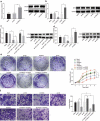LncRNA LEF1-AS1 silencing diminishes EZH2 expression to delay hepatocellular carcinoma development by impairing CEBPB-interaction with CDCA7
- PMID: 32178558
- PMCID: PMC7217375
- DOI: 10.1080/15384101.2020.1731052
LncRNA LEF1-AS1 silencing diminishes EZH2 expression to delay hepatocellular carcinoma development by impairing CEBPB-interaction with CDCA7
Abstract
Hepatocellular carcinoma (HCC) is recognized for its high mortality rate worldwide. Based on intensive studies, long non-coding RNA (lncRNA) expression exerts significant effects on tumor suppression. Herein, we investigated the molecular mechanism of lymphoid enhancer-binding factor-1 antisense RNA 1 (LEF1-AS1) in HCC cells. Microarray-based gene expression analysis was adopted to predict and verify the differentially expressed genes in HCC, which predicted cell division cycle-associated 7 (CDCA7) and LEF1-AS1 to be highly expressed in HCC. The expression of LEF1-AS1, CDCA7, CCAAT/enhancer-binding protein beta (CEBPB) and enhancer of zeste homolog 2 (EZH2) was determined by means of reverse transcription quantitative polymerase chain reaction (RT-qPCR) and western blot analysis. LncMap was used to predict the lncRNA-transcription factor-gene interaction in HCC. ChIP, RIP assay and dual luciferase reporter gene assay were employed to verify the relationship between the transcription factor and gene. Silencing of LEF1-AS1 could downregulate CDCA7 expression through CEBPB. Overexpression of LEF1-AS1, EZH2 and CDCA7 promoted proliferation and invasion in HCC cells. LEF1-AS1 promoted CDCA7 expression to further upregulate EZH2. Tumor formation in nude mice was assessed to verify the experimental results. Silencing of LEF1-AS1 inhibited the growth of tumors in vivo. Collectively, silencing LEF1-AS1 inhibited the proliferation and invasion of HCC cells by down-regulating EZH2 through the CEBPB-CDCA7 signaling pathway, which provides scientific evidence for the treatment of HCC.Abbreviations: HCC: Hepatocellular carcinoma; lncRNA: long non-coding RNA; LEF1-AS1: lymphoid enhancer-binding factor-1 antisense RNA 1; EZH2: enhancer of zeste homolog 2; CDCA7: cell division cycle-associated 7; GEO: Gene Expression Omnibus; NC: negative control; oe: overexpressed; RT-qPCR: reverse transcription quantitative polymerase chain reaction; PBS: phosphate buffered saline; HRP: horseradish peroxidase; OD: optical density; RIP: Radioimmunoprecipitation; ChIP: Chromatin immunoprecipitation; WT: wild type.
Keywords: CDCA7; CEBPB; EZH2; LEF1-AS1; hepatocellular carcinoma; invasion; proliferation; transcription factor.
Figures






Similar articles
-
Long noncoding RNA UPK1A-AS1 indicates poor prognosis of hepatocellular carcinoma and promotes cell proliferation through interaction with EZH2.J Exp Clin Cancer Res. 2020 Oct 29;39(1):229. doi: 10.1186/s13046-020-01748-y. J Exp Clin Cancer Res. 2020. PMID: 33121524 Free PMC article.
-
Silencing of long noncoding RNA LEF1-AS1 prevents the progression of hepatocellular carcinoma via the crosstalk with microRNA-136-5p/WNK1.J Cell Physiol. 2020 Oct;235(10):6548-6562. doi: 10.1002/jcp.29503. Epub 2020 Feb 18. J Cell Physiol. 2020. PMID: 32068261
-
Long noncoding RNA LEF1-AS1 acts as a microRNA-10a-5p regulator to enhance MSI1 expression and promote chemoresistance in hepatocellular carcinoma cells through activating AKT signaling pathway.J Cell Biochem. 2021 Jan;122(1):86-99. doi: 10.1002/jcb.29833. Epub 2020 Aug 12. J Cell Biochem. 2021. PMID: 32786108
-
Upregulation of lncRNA NIFK-AS1 in hepatocellular carcinoma by m6A methylation promotes disease progression and sorafenib resistance.Hum Cell. 2021 Nov;34(6):1800-1811. doi: 10.1007/s13577-021-00587-z. Epub 2021 Aug 10. Hum Cell. 2021. PMID: 34374933 Review.
-
Current Research Progress of the Role of LncRNA LEF1-AS1 in a Variety of Tumors.Front Cell Dev Biol. 2021 Dec 20;9:750084. doi: 10.3389/fcell.2021.750084. eCollection 2021. Front Cell Dev Biol. 2021. PMID: 34988073 Free PMC article. Review.
Cited by
-
Long Non-Coding LEF1-AS1 Sponge miR-5100 Regulates Apoptosis and Autophagy in Gastric Cancer Cells via the miR-5100/DEK/AMPK-mTOR Axis.Int J Mol Sci. 2022 Apr 26;23(9):4787. doi: 10.3390/ijms23094787. Int J Mol Sci. 2022. PMID: 35563178 Free PMC article.
-
Single-Cell RNA Sequencing Reveals the Role of Phosphorylation-Related Genes in Hepatocellular Carcinoma Stem Cells.Front Cell Dev Biol. 2022 Jan 4;9:734287. doi: 10.3389/fcell.2021.734287. eCollection 2021. Front Cell Dev Biol. 2022. PMID: 35059393 Free PMC article.
-
Development of a novel five-lncRNA prognostic signature for predicting overall survival in elderly patients with breast cancer.J Clin Lab Anal. 2022 Jan;36(1):e24172. doi: 10.1002/jcla.24172. Epub 2021 Dec 11. J Clin Lab Anal. 2022. PMID: 34894405 Free PMC article.
-
Mechanism of LEF1-AS1 regulating HUVEC cells by targeting miR-489-3p/S100A11 axis.PeerJ. 2023 Nov 1;11:e16128. doi: 10.7717/peerj.16128. eCollection 2023. PeerJ. 2023. PMID: 37927791 Free PMC article.
-
CDCA7 promotes TGF-β-induced epithelial-mesenchymal transition via transcriptionally regulating Smad4/Smad7 in ESCC.Cancer Sci. 2023 Jan;114(1):91-104. doi: 10.1111/cas.15560. Epub 2022 Nov 14. Cancer Sci. 2023. PMID: 36056599 Free PMC article.
References
-
- Sherman M. Hepatocellular carcinoma: epidemiology, surveillance, and diagnosis. Semin Liver Dis. 2010. February;30(1):3–16. PubMed PMID: 20175029. - PubMed
Publication types
MeSH terms
Substances
LinkOut - more resources
Full Text Sources
Medical
Miscellaneous
